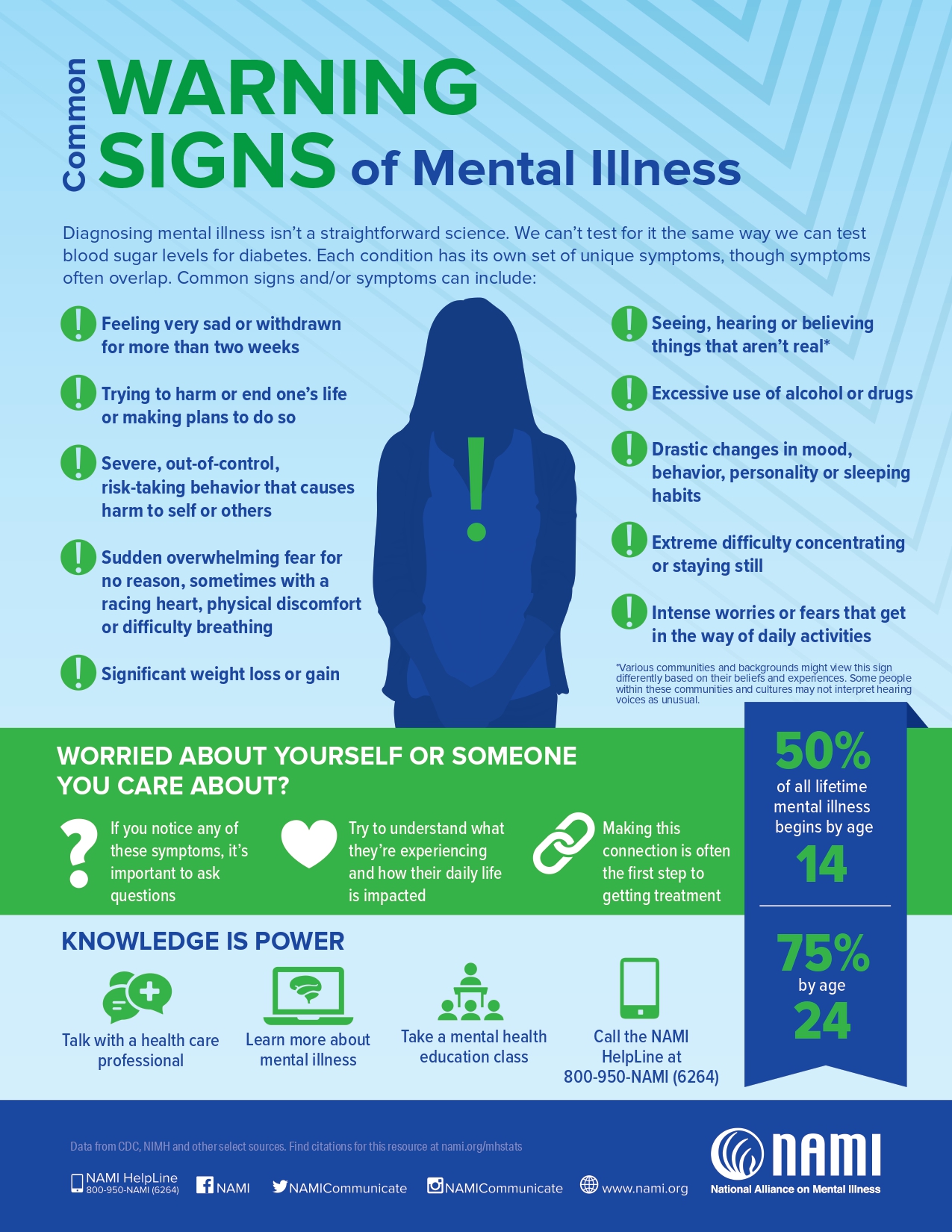Mental Health Resources
Anxiety
Anxiety is a normal and often healthy emotion, but when a person regularly feels disproportionate levels of anxiety, it might become a medical disorder. Symptoms include restlessness, feeling wound-up or on edge, a sense of dread, and difficulty concentrating on anything but persistent worry. Anxiety is often accompanied by physical symptoms such as nausea, fast heartbeat, shallow breathing, pins and needles sensations, dizziness, or panic attacks.
It affects about 31% of adults in the U.S. at some point in their lives.
- Generalized Anxiety Disorder (GAD) is characterized by persistent and excessive worry about various different things. People with GAD may anticipate disaster and may be overly concerned about money, health, family, work, or other issues.
- Panic Disorder (PD) involves repeated episodes of sudden feelings of intense anxiety and fear or terror that reach a peak within minutes (panic attacks).
- Social Anxiety Disorder involves high levels of anxiety, fear, and avoidance of social situations due to feelings of embarrassment, self-consciousness, and concern about being judged or viewed negatively by others.

For professional guidance, click here to connect with a specialist.
Anxiety Relief in Moments of Need
For those battling anxiety, our selection of exercises offers prompt grounding and solace. With videos lasting 5 to 15 minutes, these brief Hope Helping interventions provide instant calm during peak distress, bridging the gap until you reach a Hope Helper.
You Are Not Alone: Anxiety By the Numbers
- The annual prevalence of anxiety among U.S. adults is 19.1% (over 40 million people)
- Approximately 7% of children aged 3-17 experience issues with anxiety each year
- Depression and anxiety disorders cost the global economy $1 trillion in lost productivity each year
- GAD affects 6.8 million adults or 3.1% of the U.S. population, yet only 43.2% are receiving treatment.
- PD affects 6 million adults or 2.7% of the U.S. population.
Attention-Deficit/Hyperactivity Disorder (ADD/ADHD)

Treatment for ADD/ADHD typically includes a combination of medication, psychotherapy (including cognitive behavioral therapy), education or training, and support groups. Lifestyle modifications such as a healthy diet, regular physical activity, adequate sleep, and the reduction of screen time can also help manage symptoms.
Click here to connect with a specialist who can guide you through understanding and managing ADD/ADHD.
ADD/ADHD Tools:
For individuals with ADD/ADHD, our tailored Hope Helping exercises aim to enhance focus and grounding swiftly. With videos spanning 5 to 15 minutes, these interventions offer immediate structure and clarity, serving as a lifeline until you engage with a Hope Helper.
Autism Spectrum Disorder

Tools and Exercises for Autism Spectrum Disorder (ASD):
Our specially curated collection of Hope Helping exercises is tailored for those on the autism spectrum, offering grounding and immediate relief. Each resource is a brief yet impactful intervention, featuring videos spanning 5 to 15 minutes. This approach ensures that these beneficial techniques seamlessly integrate into moments of heightened sensitivity or overwhelm, providing prompt solace and acting as a support system until you connect with a Hope Helper.
Bipolar
Bipolar Disorder, previously known as manic-depressive illness, is a mental health condition characterized by extreme mood swings that include emotional highs (mania or hypomania) and lows (depression). These fluctuations are more severe than the typical ups and downs that people experience. During a manic phase, individuals may feel euphoric, irritable, or full of energy, while depressive phases can result in hopelessness, fatigue, or sadness. The exact cause of bipolar disorder remains unknown, but it’s believed to be a combination of genetic, environmental, and neurological factors. Proper diagnosis, treatment, and support can help individuals manage their symptoms and lead fulfilling lives.

Balanced Tools and Exercises for Bipolar Disorder:
For those navigating the challenges of bipolar disorder, our carefully curated exercises are crafted for moments of heightened emotion or distress. Each resource delivers a succinct yet potent intervention, with videos spanning 5 to 15 minutes. These practices extend immediate solace, acting as a grounding anchor until you reach out to a Hope Helper.
Depression
Depression is a mood disorder that causes persistent feelings of sadness or anger, loss of interest in daily activities, sleep disturbances, and low self-esteem
It can be triggered by life events, genetic factors, or changes in brain chemistry, and affects about 280 million people worldwide. Symptoms can range from mild to severe, and may be persistent, situational, or seasonal.

Guided Exercises for Depression
For those grappling with depression, our tailored collection of exercises offers grounding and a momentary reprieve. Each resource is a brief yet powerful intervention, featuring videos from 5 to 15 minutes in length. Designed for moments of intense melancholy or distress, these practices provide immediate solace and comfort, serving as an anchor until you reach out to a Hope Helper.
Grief

Everyone experiences grief differently, but common symptoms can range from shock and disbelief to profound sadness and anger. There is no right or wrong way to deal with grief, and the timeline of the grieving process is highly individual.
Meditations and Activities to Manage Grief:
For those journeying through the profound depths of grief, our thoughtfully assembled exercises extend a gentle hand of solace. Each resource in our collection offers a brief yet deeply resonant intervention, with videos spanning various durations to suit your needs. Curated for moments of profound sorrow and loss, these practices serve as a beacon of comfort, guiding you through pain and aiding in finding moments of peace until you are ready to seek further support.
Personality Disorders

Empowering Resources for Borderline Personality Disorder (BPD):
Navigating the intricacies of Borderline Personality Disorder (BPD) requires both understanding and tools tailored to its unique challenges. Our curated section of exercises, tools, and resources aims to provide individuals with BPD, and those supporting them, with strategies to cope, heal, and thrive. Whether you’re seeking grounding techniques during emotional upheavals, strategies to foster stable relationships, or ways to better understand and manage mood shifts, our collection is designed to be your guiding companion on this journey toward balance and well-being.
Empowerment Against Narcissistic Patterns:
Navigating relationships with narcissists or recognizing narcissistic tendencies within oneself can be a challenging endeavor. Our curated collection of resources is designed to shed light on these patterns and provide tools to engage with them constructively. Each resource offers insights and coping mechanisms to foster understanding, set healthy boundaries, and cultivate self-awareness. These practices are a supportive step, bridging the path to deeper introspection or guiding interactions with those exhibiting narcissistic behavior.
Narcissism and Narcissistic Personality Disorder
Narcissism refers to an inflated sense of one’s importance, a deep need for excessive attention and admiration, and often a lack of empathy for others. Rooted in self-centeredness, those with narcissistic tendencies may come across as arrogant or superior, but beneath that facade often lies vulnerability to even slight criticism. It’s essential to note that while we all exhibit narcissistic traits at times, severe forms of narcissism can manifest as a personality disorder known as narcissistic personality disorder (NPD). This condition can lead to strained relationships, challenges at work or school, and a need for constant validation. Recognizing and understanding narcissism is vital for both individuals and those interacting with them to navigate relationships and situations effectively.
Obsessive Compulsive Disorder (OCD)

Tools for Navigating OCD
Post-Traumatic Stress Disorder (PTSD)

Need to talk to someone about PTSD? Click here to speak to a specialist.
Rediscovering Calm: Resources for Navigating PTSD
Post-Traumatic Stress Disorder (PTSD) is a profound response to deeply distressing events, leaving lingering imprints of fear, anxiety, and heightened vigilance. The journey to recovery requires patience, understanding, and the right set of tools. To aid in this healing process, we’ve crafted a selection of exercises tailored for individuals with PTSD. These practices, from guided meditations to cognitive-behavioral techniques, aim to alleviate traumatic symptoms, foster resilience, and support a return to a sense of safety and equilibrium. Let these exercises be your guide and anchor as you navigate the challenges of PTSD and work towards reclaiming your peace and well-being.
Schizophrenia

Guided Resources for Schizophrenia
Navigating the complexities of schizophrenia necessitates specialized tools and insights. Our collection of resources, exercises, and tools is meticulously curated to support individuals with schizophrenia and their loved ones. From grounding techniques to coping strategies, each resource is designed to offer guidance, foster understanding, and promote well-being in the journey toward managing and living with this condition.
Stress
To manage and mitigate the impact of stress in our lives, it’s essential first to understand its distinct forms. Here, we delve into four common types of stress: chronic stress, acute stress disorder, episodic acute stress, and emotional stress

Chronic Stress
Chronic stress is a prolonged and constant feeling of stress that can negatively affect health if left unmanaged. It arises when one is repeatedly exposed to stressors over an extended period. Whether stemming from financial struggles, unsatisfying work, or long-term disease, this relentless form of stress can lead to serious health issues such as heart disease, diabetes, and depression.
Acute Stress Disorder
Acute Stress Disorder (ASD) is a short-term condition that occurs immediately following a traumatic event. It encompasses a range of severe emotional and physical symptoms, from anxiety and numbness to episodes of reliving the trauma. ASD is different from post-traumatic stress disorder (PTSD) in that its symptoms occur within three days to four weeks after the trauma, but if not addressed, ASD can evolve into PTSD.
Episodic Acute Stress
Those who frequently experience acute stress, or whose lives present frequent triggers of stress, suffer from episodic acute stress. It’s common among people who take on too many responsibilities, always seem disorganized, and often find themselves in avoidable stressful situations. This recurrent pattern can lead to persistent irritability, tension headaches, and even heart disease.
Emotional Stress
Emotional stress manifests as a result of adverse personal experiences or situations, such as relationship conflicts, workplace challenges, or the death of a loved one. Unlike other stress types, which might have a more defined source, emotional stress often intermingles with personal perceptions, feelings, and reactions, making it particularly challenging to pinpoint and manage. If not addressed, it can lead to mental health issues like depression or anxiety.
For professional help managing stress, click here to connect with a specialist.
Navigating Stress: Practical Exercises for Well-being
Life’s demands can often lead us into the throes of stress, challenging our emotional equilibrium and physical health. Recognizing and combating these stressors is vital for maintaining our overall well-being. To assist you on this journey, we’ve curated a selection of exercises specifically designed to address various stress forms. From grounding techniques to mindfulness practices, these tools aim to offer relief, foster resilience, and empower you to navigate life’s challenges with greater ease and clarity. Whether you’re grappling with fleeting tensions or persistent pressures, these exercises offer a pathway to tranquility and balance.
Substance Use Disorder

Journey to Recovery: Empowering Tools for Substance Disorders
Substance disorders can cast a shadow over one’s life, often intertwining with emotional pain, physical dependency, and societal pressures. The path to recovery, while challenging, is illuminated by understanding, self-awareness, and the right tools. Our collection of exercises is purposefully curated to assist those grappling with substance disorders. Whether you’re seeking strategies to manage cravings, techniques to ground oneself during triggers, or ways to rebuild self-worth, these exercises act as beacons on your journey. Embrace them as steadfast companions in your pursuit of healing and a substance-free life.
Trauma

Healing Pathways: Tools for Navigating Trauma
Trauma, whether rooted in a singular event or accumulated over time, leaves imprints on the mind and body that can influence our perceptions, emotions, and reactions. Healing from such profound experiences is a personal and often complex journey. To support this process, we’ve curated a collection of exercises specifically tailored for trauma survivors. These tools, ranging from grounding techniques to therapeutic practices, aim to provide solace, empowerment, and understanding. They serve as guideposts, helping you reconnect with your inner strength and move forward with resilience and hope. Embrace these exercises as nurturing allies on your path to healing and rediscovery.
Common Warning Signs of Mental Illness

It’s Okay to Talk About Suicide
- Suicide is the 2nd leading cause of death among people aged 10-14 and the 3rd leading cause of death among those aged 15-24 in the U.S.
- Suicide is the 12th leading cause of death overall in the U.S.
- 46% of people who die by suicide had a diagnosed mental health condition
- 90% of people who die by suicide may have experienced symptoms of a mental health condition, according to interviews with family, friends and medical professionals (also known as psychological autopsy)
- Annual prevalence of serious thoughts of suicide, high risk populations:
- Lesbian, gay and bisexual youth are nearly 4x more likely to attempt suicide than straight youth
- 79% of people who die by suicide are male
- Transgender adults are nearly 9x more likely to attempt suicide at some point in their lifetime compared to the general population
Trauma
California’s Statewide Hotlines/Resources
988 Suicide and Crisis Lifeline
988 or text 988 (24/7)
Crisis Text Line
Text HOME to 74174
Veterans Suicide Crisis Line
1-800-8255 and Press 1
California Parent and Youth Helpline
1-855-427-2736
CalHOPE
833-317-HOPE (4673)
RAINN National Sexual Assault Hotline
1-800-656-HOPE (24/7)
Trevor Project (LGBTQ youth)
Call 1-866-488-7386 or text START to 678678 (24/7)
California Youth (ages 12-24) Crisis Line
Call or text 1-800-843-5200 or chat online (24/7)
Trans Lifeline
The Trans Lifeline’s Hotline is a peer support phone service run by trans people for our trans and questioning peers. Call us if you need someone trans to talk to, even if you’re not in crisis or if you’re not sure you’re trans. Call (800) 877-565-8860 open 24/7 but staff is limited. Guaranteed to be available from 2 pm –10 pm PST.
SAMHSA
SAMHSA’s National Helpline is a free, confidential, 24/7, 365-day-a-year treatment referral and information service (in English and Spanish) for individuals and families facing mental and/or substance use disorders.
Teen Line
Call (800) 852-8336 (6 pm– 10 pm PST)
Text TEEN to 839863 (6 pm –10 pm PST). Offering anonymous support for teenagers by phone, text or email. No problem is too small, too large or too shocking for the trained volunteers.
